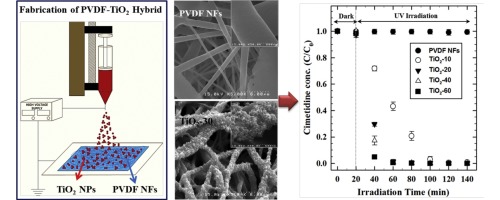Publication
Advanced Redox Technology Lab
Publication
Advanced Redox Technology Lab
Journal papers
A paper-like photocatalyst was fabricated by electrospraying an N,N′-dimethylformamide (DMF) dispersion of titanium dioxide (TiO2) nanoparticles (NPs) on a poly(vinylidene fluoride) nanofiber (PVDF NF) mat prepared by electrospinning. Morphological studies revealed that the TiO2 NPs uniformly deposited as clusters on the surface of the PVDF NF mat. The immobilized amount of TiO2 was found to be 2.08, 2.44, 3.80, and 4.73 mg per 45 cm2 of PVDF–TiO2 hybrids for the electrospraying of 10, 20, 40, and 60 ml of TiO2–DMF, respectively. The hybrid photocatalysts were effective in degrading bisphenol A (BPA), 4-chlorophenol (4-CP), and cimetidine (CMT), which dissolved in both deionized water and secondary wastewater effluents, with activity being proportional to the quantity of TiO2 NPs immobilized. For the highest loading amount of TiO2, BPA, 4-CP, and CMT degraded completely within 100, 100, and 40 min of UV irradiation, respectively. Stable photo-oxidation of CMT was maintained through 10 repeated cycles. During these cycles, it was confirmed that there was no loss of TiO2 NPs by inductively coupled plasma optical emission spectrometry. Our results suggest that effective and stable PVDF–TiO2 hybrid photocatalysts can be fabricated on a large scale by combining electrospinning and electrospraying techniques.
